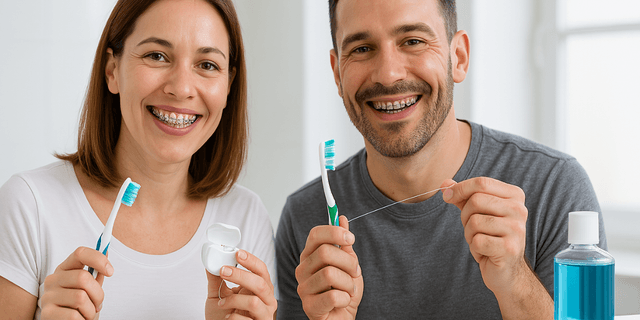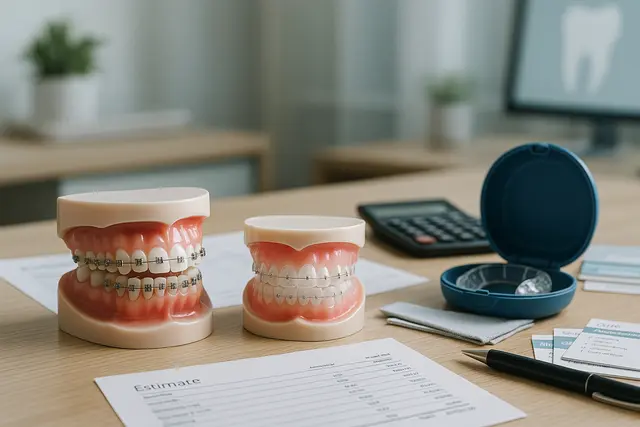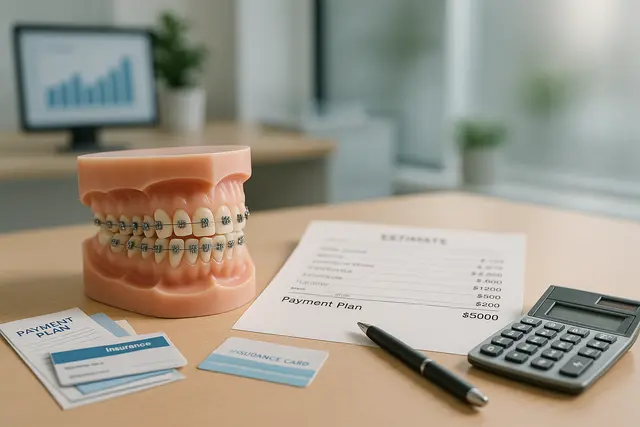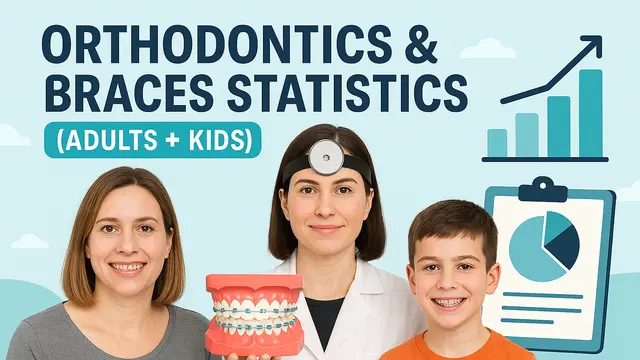Orthodontics
6 min read
Apr 03, 2025
Caring for Your Braces: Cleaning Tips, Foods to Avoid, and Maintenance
Braces help correct misaligned teeth and improve your bite. They’re a long-term investment in your dental health, but they also require daily responsibility. Cleaning effectively, choosing the right foods, and keeping up with maintenance appointments will help protect your teeth and make your treatment go more smoothly.

Cleaning Your Braces
Keeping your braces clean isn’t optional, it’s the foundation of successful orthodontic treatment. Brackets and wires create more surfaces for plaque to hide, and if not cleaned properly, this can lead to tooth decay, gum inflammation, and stains that may only become visible after the braces are removed.
Brushing with Braces
Regular brushing becomes non-negotiable while wearing braces. Use a soft-bristle toothbrush or an electric model designed for orthodontic care. It’s best to brush after every meal, not just morning and night, to clear out trapped food.
Position the brush at a 45-degree angle above and below the brackets. Brush each bracket directly, then clean the gumline and the chewing surfaces. Don’t rush, two full minutes is the minimum. Failing to clean thoroughly can lead to white spot lesions or cavities that delay your progress.
Flossing with Braces
Flossing won’t be as quick as it used to be, but skipping it leaves too much plaque behind. Use a floss threader or special orthodontic floss to get underneath the wires. Gently guide the floss between your teeth, and clean down to the gumline without snapping or forcing it. Water flossers are a good backup or supplement but shouldn’t replace manual flossing entirely.
Tools to Help
To make the cleaning process more efficient, consider adding a few tools to your routine:
Interdental Brushes: These fit between the braces and teeth where a regular brush can’t reach.
Water Flossers: Especially helpful for removing larger debris and flushing hard-to-reach areas.
Mouthwash: An alcohol-free rinse used once daily helps reduce bacteria and supports gum health.
Staying on top of oral hygiene with braces takes effort, but it pays off. A clean mouth supports faster, healthier progress and better long-term results.
Foods to Avoid with Braces
Sticking to the right diet helps protect your braces and prevents setbacks in treatment. Eating the wrong foods can damage wires or brackets, which often results in unplanned visits to the orthodontist and delays in progress.
Hard Foods
These put direct pressure on the brackets and wires and can snap or loosen them easily. Avoid items such as:
Nuts
Hard candies
Ice
Popcorn kernels
Even small hard particles can get lodged between brackets or under wires, causing irritation or damage.
Sticky or Chewy Foods
These types of foods stretch and pull on your braces. They’re difficult to clean off and often lead to plaque buildup.
Gum (even sugar-free)
Caramel and toffee
Gummy candies
Taffy
Sticky residue lingers, increasing the risk of cavities and staining.
Crunchy Foods
Crunchy foods aren’t always off-limits, but they need modification. Large, hard bites can be risky, especially with front brackets.
Raw vegetables should be cooked or cut into very thin strips.
Fruits like apples should be sliced; avoid biting directly.
Corn should be removed from the cob before eating.
The goal is to eliminate pressure points on the braces.
Sugary Foods and Drinks
Excess sugar feeds bacteria, speeding up plaque formation. This is especially problematic when sugar collects around brackets and wires.
Avoid sodas, energy drinks, and sweetened teas.
Limit candy and processed snacks.
Even when brushing regularly, these sugars can break down enamel if they sit too long on the tooth surface.
In general, think in terms of consistency and risk. If something requires force to bite or tends to stick to your teeth, it’s likely not a good match for braces. Choose softer alternatives and cut food into manageable portions to reduce stress on your orthodontic hardware.
Maintenance and Appointments
Braces require consistent follow-up to work as intended. Skipping appointments or ignoring issues can delay results or create complications. Regular check-ins and careful self-monitoring help keep your orthodontic treatment on track.
Orthodontic Checkups
Braces need periodic adjustments to maintain pressure and guide tooth movement. These adjustments typically occur every 4 to 6 weeks. During checkups, your orthodontist will tighten wires, replace elastics, and assess progress. If you miss appointments, your timeline may be extended. Always report changes or discomfort in between visits, early intervention can prevent bigger problems later.
What to Do If Something Breaks
Brackets and wires aren’t indestructible. If a wire loosens or a bracket breaks, avoid trying to fix it yourself beyond immediate comfort measures. Use orthodontic wax to cushion sharp edges and call your orthodontist promptly. If necessary, you can trim a protruding wire with clean nail clippers as a temporary solution, but only if you’ve been advised to do so.
Protecting Your Braces During Activities
If you’re active in sports, use a mouthguard, preferably a custom one from your orthodontist. Even light physical contact can cause damage to your braces or mouth. Also, avoid habits like chewing on pens, pencils, or fingernails. Repeated pressure from these actions can weaken brackets and wires over time.
Monitoring Progress
Some pain or tightness is normal after an adjustment. Monitor how long it lasts and how severe it is. Persistent discomfort, unusual tooth movement, or signs of gum recession should be reported. Your orthodontist may adjust your treatment plan, but only if you’re consistent with care and communication. Keep track of changes and stick to recommendations, real progress starts with small, daily habits.
Questions and Answers
How do you brush properly with braces?
Use a soft-bristled toothbrush and brush after every meal. Angle the brush to reach above and below each bracket. Clean all surfaces, including the brackets and wires themselves. Two minutes is the minimum; go longer if needed to remove all debris.
How often should you floss with braces?
Floss once a day, every day. Use a floss threader or a pre-threaded orthodontic floss to guide the floss behind the wire. Be careful around the gums, but don’t skip it, plaque builds up fast between teeth.
What foods should you never eat with braces?
Avoid hard, sticky, and chewy foods. That includes things like popcorn, hard candy, gum, caramels, nuts, and ice. These aren’t just difficult to clean, they can damage your braces.
Can you drink soda with braces?
You can, technically, but you shouldn’t. Soda contains sugar and acid, both of which erode enamel and get trapped around brackets. Drinking it regularly raises your risk for tooth decay during treatment.
What happens if a bracket breaks?
Call your orthodontist to report it. Don’t try to reattach it yourself. If it’s causing irritation, use orthodontic wax as a temporary fix. Avoid chewing on that side until it’s repaired.
How do you relieve soreness after getting braces tightened?
Eat soft foods, rinse with warm salt water, and use over-the-counter pain relievers if needed. The discomfort is temporary and usually eases within 24 to 48 hours.
Do braces cause bad breath?
If you don’t clean well, yes. Food particles trapped around brackets can break down and cause odor. Brush after every meal, floss daily, and use alcohol-free mouthwash to keep your breath fresher.
What’s the best toothbrush for braces?
A soft-bristle manual toothbrush works, but an electric toothbrush with an orthodontic setting can provide more consistent pressure and reach. What matters most is technique and frequency.
How do you keep braces clean at school or work?
Carry a travel kit with essentials: toothbrush, toothpaste, floss threader, and wax. If you can’t brush, rinse your mouth well with water after eating to remove loose food particles.
When are braces removed?
It depends on your specific case. Treatment usually lasts between 12 and 36 months. Your orthodontist tracks your alignment and will remove the braces once your teeth reach their planned positions.
How Often Should You Brush and Floss With Braces?
Brush after every meal using a soft-bristled or electric toothbrush, angling it to clean around brackets and wires. Floss once daily using a floss threader or orthodontic floss to remove plaque between teeth. Consistency is key to preventing cavities, staining, and gum issues during treatment.
What Foods Should You Avoid While Wearing Braces?
Avoid hard, sticky, and chewy foods like nuts, popcorn, caramel, and gum. These can damage your braces or get stuck in difficult-to-clean areas. Instead, choose softer alternatives and cut foods into small, manageable pieces to reduce strain on brackets and wires.
What Should You Do If a Bracket or Wire Breaks?
If a bracket breaks or a wire becomes loose, don’t try to fix it yourself. Use orthodontic wax to protect soft tissue from irritation and call your orthodontist right away. If instructed, you may trim a poking wire with clean clippers, but only as a temporary solution.
How Can You Keep Your Braces Clean at School or Work?
Pack a small oral care kit with a toothbrush, toothpaste, floss threader, and orthodontic wax. After meals, brush when possible or at least rinse with water to remove food particles. Staying prepared helps maintain hygiene and prevents plaque buildup throughout the day.
Read Next
Related Posts

Orthodontics
Retainer That Looks like Braces: Benefits for Long-Term Alignment
A retainer might not get as much attention as braces, but it plays a crucial role in maintaining your smile after orthodontic treatment. Whether you're new to retainers or curious about the type that looks like braces, understanding their purpose and benefits is key to keeping your teeth aligned for the long haul.
6 min read
Sep 15, 2025

Orthodontics
How Much Are Metal Braces? Cost Comparison With Other Options
Thinking about getting braces but overwhelmed by the cost? You’re not alone. Orthodontic treatment can be a major investment, and understanding the different price points, from metal braces to clear aligners, can help you make a smart, confident decision.
5 min read
Sep 15, 2025

Orthodontics
Orthodontics & Braces Statistics (Adults + Kids)
Orthodontics has transformed from a niche medical service for teenagers into a booming sector that spans all ages. Today, both adults and children seek orthodontic treatment to improve their smiles, fix bite issues, and boost self-confidence.
4 min read
Aug 21, 2025
Don’t have time to research every dentist around you?
See why 30k+ patients trusted us